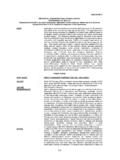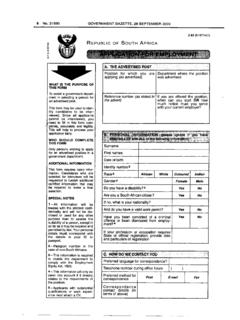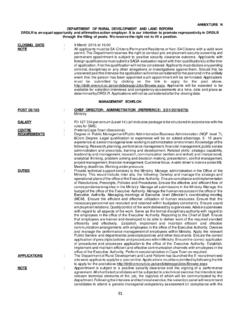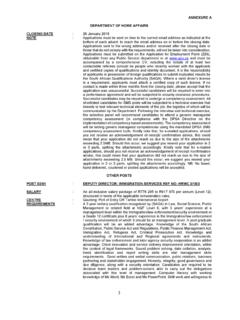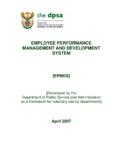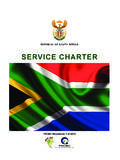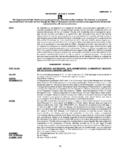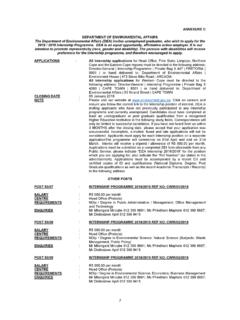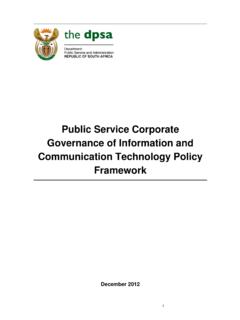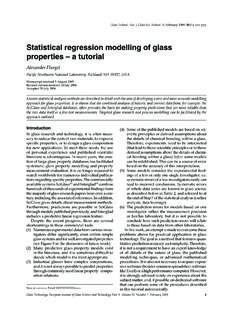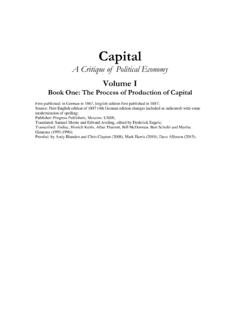Transcription of Senior Management Service Handbook 2003
1 PUBLIC Service Handbook SENIORMANAGEMENTSERVICEFOREWORD TO THE SMS Handbook BY THE MINISTER FOR THEPUBLIC Service AND ADMINISTRATIONI mproved Service delivery remains a fundamental priority of government. Toachieve this we need a modern, people-centered public Service -a publicservice that accepts both the challenges and opportunities of being a primaryagent of the developmental state. To fulfil this role requires a flexible andcreative public Service , prepared for innovation and collaboration, working inpartnership with all stakeholders, be they the community, other governmentdepartments and organs of state, the private sector, civil society organisationsor international cannot be achieved without capable, committed, strong leadership andmanagement. The modern public Service requires leaders with an array ofskills, both hard and soft, in order to manage competing policy priorities andmandates, in complex organisational environments inhabited by people whobring with them a wide range of backgrounds, cultures and Senior Management Service Programme was developed out of therecognition of the critical role that Management plays in the effective andefficient functioning of the Public Service .
2 Strengthening leadership andmanagement capacity in government is its core function. The challenge forthe Public Service is to recruit, develop and retain competent leaders andmanagers and to reward them for good performance, recognising excellenceand is the responsibility/task of our Senior managers to convert the policymandates of government into effective departmental strategies, plans andprograms. It is their responsibility to ensure that resources both materialand human are effectively used and accounted for in the pursuit ofperformance purpose of this Handbook is set out, in clear and concise terms, theconditions of employment and the roles of SMS members. This Handbook willbe an invaluable tool to guide and inform, not only Senior managers in thePublic Service particularly those new to the SMS but also other sectorsand those who aspire to join this cadre of leaders in delivering a better life forthe people of our sms handbookSMS Handbook Table of contents 1/12/2003 SMS Handbook 2003 EDITION Department of Public Service and AdministrationSMS Handbook Table of contents 1/12/20032 TABLE OF CONTENTSGLOSSARY OF TERMSCHAPTER 1 OVERVIEW1.
3 Purpose of Handbook2. Legal mandate3. Overview of contents4. SMS Handbook on-lineCHAPTER 2 RECRUITMENT AND SELECTION1. Introduction2. Mandatory and regulatory framework3. Establishing the need for recruitment4. Job profile5. Recruitment agencies6. Recruitment7. Advertising of posts8. SelectionAnnexure A Recruitment and selection cycleAnnexure B Example of advertisementCHAPTER 3 REMUNERATION AND CONDITIONS OF of of the remuneration of the inclusive flexible conditions of payment for additional compensation to heads of flying creditsAnnexure A Examples of structure of inclusive packagesAnnexure B Examples of structuring of flexible portionAnnexure C Annual leave days with regard to member categorySMS Handbook Table of contents 1/12/20033 CHAPTER 4 PERFORMANCE Management AND DEVELOPMENT1. Introduction and context2. Purpose3. Date of implementation4. Key principles5. Regulatory framework6. Integration of the PM & D system with all otherorganisational processes7.
4 Linking the PM cycle to planning and budgeting8. Entering into a performance agreement9. Contracting and determination of assessment criteria10. Contents of the performance agreement11. Application of the CMC12. Review and appraisal13. Assessment instrument for annual performance appraisal14. Annual performance appraisal process15. Using performance appraisal to allocate rewards and deciding on keycareer incidents16. Oversight and moderation17. Recording performance related data18. Confidentiality19. ReportingAnnexure A - Summary of Performance Management and Development SystemAnnexure B - Mandatory elements in the performance Management and development systemAnnexure C - Performance Management and Development CycleAnnexure D - Senior Management performance agreementAnnexure E - Generic core Management criteria (CMC) and standardsAnnexure F - Senior Management performance review formAnnexure G - Annual performance assessment instrumentAnnexure H - Assessment rating calculatorSMS Handbook Table of contents 1/12/20034 CHAPTER 5 COMPETENCY FRAMEWORK1.
5 Introduction2. Scope of applicability3. Establishing the need for competency profiling4. Structure of the competency framework5. Application of the competency framework6. Competency frameworkCHAPTER 6 ETHICS AND CONDUCT1. Introduction2. Mandatory and regulatory framework3. Values and principles4. Responsiveness and impartiality5. Accountability6. Leadership7. Communication8. Management of misconduct9. Confidentiality of official information10. Financial and other private interests (Disclosure)11. Political participation12. Outside employment13. Labour relations14. Intellectual property15. Access to information and administrative justice16. ConclusionCHAPTER 7 MISCONDUCT AND code and procedures for code and procedures for procedures in respect of ill healthAnnexure A Acts of misconductAnnexure B Written warningAnnexure C - Final written warningAnnexure D Notice of disciplinary hearingSMS Handbook Table of contents 1/12/20035 CHAPTER 8 EMPLOYMENT OF HEADS OF DEPARTMENTS1.
6 Introduction2. Delegation of powers3. Advertising4. Re-advertising vacancies5. Selection6. Appointments7. Employment contracts8. Performance agreements9. Probation10. Remuneration and Service conditions11. Overtime12. Deployment13. Transfers14. Secondment15. Extension of term of office16. Acting as HoD17. Ethical conduct18. Suspension19. Disciplinary procedure20. Grievances21. Incapacity code and procedures for the public Service in respect of poorwork performance22. Incapacity code in respect of ill health23. Termination of contract of employmentAnnexure A Delegation of powersAnnexure B Principles and procedures on recruitment and selectionAnnexure C - Cabinet memorandumAnnexure D Covering letterCHAPTER 9 FINANCIAL DISCLOSURE1. Introduction2. Framework3. Responsibility of Executing Authorities4. Responsibilities of SMS membersAnnexure A Financial Disclosure form AAnnexure B General InformationSMS Handbook Table of contents 1/12/20036 APPENDICESA ppendix 1 Resolution No.
7 13 of 1998 Appendix 2 Resolution No. 9 of 2000 SMS Handbook Glossary of Terms 1/6/2003 GLOSSARY OF TERMSAct Public Service Act, 1994 BPBatho PeleCMCCore Management CriteriaDPSAD epartment of Public Service and AdministrationEAExecuting AuthorityGEPFG overnment Employees Pension FundHandbookHandbook on Senior Management ServiceHoDHead of national department/provincialadministration/prov incial department/organisationalcomponent as identified in Schedules 1 to 3 of the ActHRHuman ResourcesKRAKey Result AreasMemberMember of the Senior Management ServiceMPSAMTEFPAM inister for the Public Service and AdministrationMedium Term Expenditure FrameworkPerformance AgreementPFMAP ublic Finance Management Act, 1999PM&DPerformance Management and DevelopmentPMPerformance ManagementPMSP erformance Management SystemPSCP ublic Service CommissionPSCBCPSRP ublic Service Co-ordinating Bargaining CouncilPublic Service Regulations, 2001 SANDFS outh African National Defence ForceSMSenior ManagerSMSS enior Management Service1 CHAPTER 1 SMS Handbook Chapter 1 Overview 1/12/2003 CHAPTER OF Handbook The publication of the first edition of this Handbook coincidedwith the establishment of the SMS on 1 January 2001.
8 This isthe second edition, which incorporates all the determinations,directives and guidelines issued by the Minister for the PublicService and Administration to the SMS as at 1 December For ease of administration, the DPSA will endeavour toincorporate all future amendments to the policies, advice andguidance that pertain to the employment and conditions ofservice of the SMS in this Handbook . Departments should,however, note that the details concerning the rand value ofremuneration packages of Senior managers will be contained inseparate DPSA Handbook is issued in terms of regulation 1 D of chapter 4of the Handbook must always be read in conjunction with the Act,the PSR, relevant collective agreements and should take cognisance of the fact that differentchapters of the Handbook consist of both compulsory andadvisory OF Handbook consists of chapters dealing with:(1) Overview(2) Recruitment and Selection(3) Remuneration and Conditions of Service (4) Performance Management and Development(5) Competency Framework(6) Ethics and Conduct(7) Misconduct and Incapacity(8) Employment of Heads of Departments(9) Financial DisclosureSMS Handbook Chapter 1 Overview 1/12 In addition to the above, the two resolutions of the PSCBC thatdeal with the SMS specifically, have been attached asappendices.
9 These are:(1)Appendix 1 - Resolution No. 13 of 1998(2)Appendix 2 - Resolution No. 9 of chapters focusing on matters to be identified will be addedas they are developed and approved by the Minister. Suchchapters, as well as any amendments that may be effected toexisting chapters, will be circulated to all Departments are encouraged to appoint specific persons whowill disseminate the amendments to individuals and issue themwith copies of the Handbook ON-LINE For an updated electronic copy of the Handbook , please or 2 SMS Handbook Chapter 2 Recruitment and Selection 1/12/2003 CHAPTER 2 RECRUITMENT AND purpose of this chapter is to encourage good practice in therecruitment and selection of members of the SMS, thereby assistingdepartments in appointing high quality candidates. This chapter isadvisory in nature and must be read in conjunction with A toolkit onrecruitment and selection issued by the Public Service elements of the recruitment and selection process are setout in the Act, the PSR and other laws of general application.
10 Wherenecessary cross-references will be made to these statutory diagram reflecting the recruitment and selection cycle, is attached asAnnexure A of this AND REGULATORY legal framework for recruitment and selection is provided by theConstitution of the Republic of South Africa, 1996, the Labour RelationsAct, 1995, the Employment Equity Act, 1998 and the Public Service Act,read in conjunction with the a nutshell the Constitution (Chapter 10) requires that good humanresource practices be cultivated with employment and personnelmanagement practices based on ability, objectivity, fairness and theneed to redress the imbalances of the past to achieve Act takes these principles one step further by requiring in section11 that all the persons who qualify for the appointment, transfer orpromotion shall be considered . Furthermore the evaluation of personsshall be based on training, skills, competence, knowledge and theneed to redress the imbalances of the , objective PSR includes a number of key principles on which recruitment andselection must be based.
